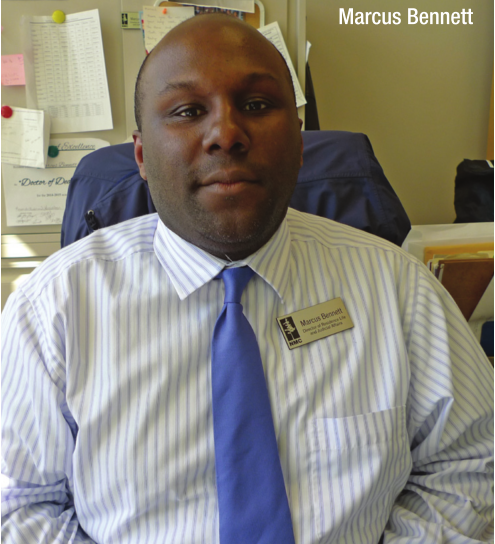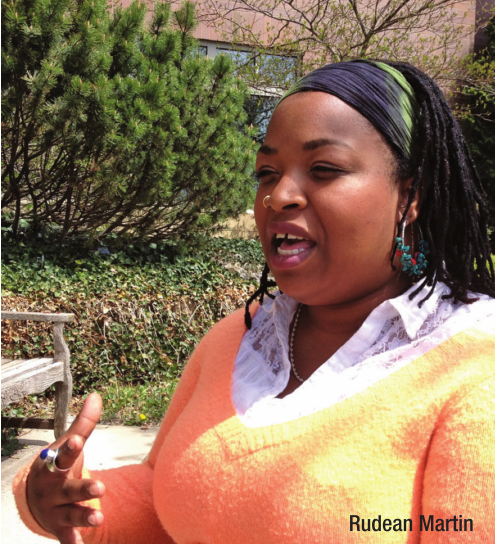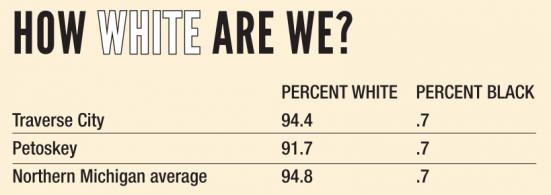The Blinding Whiteness of Northern Michigan
May 17, 2015
Northern Michigan isn’t just white in the wintertime. It’s white all year round. Depending on your exact location, it’s between 94 and 97 percent white. That makes it an interesting and complicated place for the few African Americans who call northern Michigan home.
More than 14 percent of all Michigan residents are black, but in most places in the northern Lower Peninsula, African Americans make up less than one percent of the population.
Some employers believe the lack of diversity prevents talented professionals from relocating here; some historians believe the region’s whiteness is tied to its primary industry; and the African American residents of northern Michigan themselves? They report mostly to positive experiences within a life of the "one percent."
THE ONE PERCENT
Marcus Bennett didn’t know much about northern Michigan when he moved here from Saginaw four years ago. Traverse City represented an opportunity. At Saginaw Valley State University, Bennett was an assistant residence hall director. At Northwestern Michigan College, he is director of residential life and judicial affairs, and he’s working on his doctorate.
"My ultimate goal one day is to be dean of students, so it’s kind of preparing me for that role," Bennett said.
Bennett, whose wife is white and has family in the area, had visited the region several times, but he had only experienced Traverse City in the height of summer when the town was filled National Cherry Festival visitors.
Bennett soon discovered that Traverse City’s tourists are more diverse than its residents. He recalls when he learned that the school district’s black population was less than one percent. He remembers the novelty of running into another African American man at Meijer.
"There was another gentleman who was African American and he was like, "˜hey, you’re not from around here,’" Bennett said. "And I said, "˜yeah, well, we just moved up here.’ And he was like, "˜well, I’m glad to see there’s another black person up here in Traverse City,’ so we chuckled, you know."
WHERE DO YOU GET A HAIRCUT?
Despite being a member of a super minority, Bennett does not feel out of place or uncomfortable.
"I’ve enjoyed it. I’ve never felt any time discriminated against," he said. "No complaints."
If anything, it’s the mundane things he finds frustrating.
"For me, it’s where do you go to get a haircut? I mean, that’s a big thing in terms of African American culture," he said.
It’s also hard for Bennett to find food that reminds him of home.
Traverse City Chamber of Commerce President Doug Luciani agrees the lack of services is a problem.
"It’s unintentionally not welcoming because you can’t serve a diverse group of people as an entrepreneur if that diverse group doesn’t live here," Luciani said. "So, why would you set up a barber shop for African Americans if you’re going to have a very small clientele?" African Americans in northern Michigan must encounter a sea of faces unlike their own.
"My brothers were here and then they left, and I had a girlfriend move here, and she left," said Rudean Martin, a 34-year-old music student at Northwestern Michigan College. "They probably just miss the African American community. It is different."
Martin moved to Traverse City from Kalamazoo in 2007 in order to be closer to her daughter, who had moved to Kalkaska with her white father.
"My background is a little different because I was raised in orphanages and foster care. There was a time when I lived with a white family, so I’ve kind of learned. It’s not as shocking to me because I’ve lived both sides," she said.
BAD REPUTATION
Before Martin moved north, she was warned that northern Michigan might be unfriendly.
"I did have some people say to me, when I was living in more urban areas, people did talk about that it was racist up here," Martin said.
For some blacks who live in metro Detroit, Northern Michigan is perceived to be the destination of the "white flight" from Detroit, she said.
"They talked about a time, I think it was the 60s or 70s, when a lot of African Americans moved to Michigan from the South, and they talked about how a lot of the Caucasians that were living in Detroit moved out at that time because they didn’t want to live with the black people," Martin said. "And they said that they all came up here."
Martin has experienced racism. "This was years ago and I feel that things have improved here, but I’ve had people yell out racial slurs to me as I’m walking down the street," she said. "I actually had a guy tell me, just flat out, that he doesn’t rent to black people. He doesn’t rent houses to black people. So that was an experience."
Other experiences have been positive. Through a Christian church, Martin found a group of people who practiced Buddhist yoga, something that’s helped her get traction in life. She has also met many friendly and supportive northern Michigan residents.
"There’s racism everywhere; there’s ignorance everywhere," Martin said. "I think for the most part, Traverse City is a pretty openminded, really loving community."
WHY SO WHITE?
Northern Michigan is so white today because it never developed large industry, according to Dr. Benjamin C. Wilson, professor emeritus of Africana studies at Western Michigan University.
"If there were a lot of business opportunities and manufacturing concerns, you might have attracted more black folk who were more Southern born," Wilson said. "Heck, in Muskegon County, in 1860, there were only 28 black people, but in the 1900s – we’re talking about the 1930s to the 1950s – the sheet metal factories appeared, then you began to see people attracted to the sheet metal factories, trying to escape the burdensome job of being a sharecropper or tenant farmer."
Farther north, no black population took hold above Idlewild, the Lake County resort that was once an African American performance and tourism center.
There was a black settlement in Emmet County called Freedom, but it vanished almost as soon as it appeared.
"Emmet County had 934 African Americans in 1860. Antrim County had one black person. Mackinaw had one. Delta, in the U.P., had one," Wilson said.
By 1870, Emmet County’s African American population had vanished. Wilson believes those people stopped on the way to Canada on the Underground Railroad and, by 1870, they had reached Canada or returned to American cities for work.
"Who wants to live up north, especially if you’re a person of color?" Wilson said. "It would have been tough for African Americans to live in northern Michigan because it was so white and conservative at the time."
WHAT’S GOOD ABOUT DIVERSITY

What does the lack of diversity say about the region? Why should diversity be valued?
"Diversity is one of the things that makes this country so damn unique," Wilson said. "Imagine if everybody in America, in Michigan, only ate McDonald’s hamburgers, OK?
This place would be boring as hell."
Diversity makes a community better because people learn when they interact with people from different backgrounds, Bennett said. He sees this play out at NMC.
"It’s very important because you’re going to see a perspective you may have never thought of," Bennett said. "I may have someone here from the Upper Peninsula and I may have someone from the grass roots of urban Detroit, and they’re roommates, but they learn from each other."
Life education is as important as the classroom, he said.
"I think that’s the greatest thing about diversity. Are you willing to put yourself out there?" Bennett said. "I always tell students here: you come to college to get an education, but a lot of the education you get is not in the classroom. It’s going to be what you do outside the classroom."
A PROBLEM FOR EMPLOYERS
The region’s lack of diversity is a problem for employers like Munson Medical Center and NMC. The overwhelming whiteness makes it difficult to attract technology or medical professionals, Luciani said.
"In many instances, those people in those subspecialties are from the Middle East or from Asia or from South America, and it’s really hard to get them to move here and stay here because they see a lack of diversity," he said.
A decade ago, the hospital and the college got together in an effort to address the problem. They established groups to study why there was so little diversity here.
"Some of the reasons we came up with were that it’s expensive to live here – the same reasons why there aren’t a lot of young professionals who live here. It’s expensive to live here. The wages are lower," Luciani said. "Somebody who is not from here, but accustomed to an urban area, for instance, might say, "˜well, why would I move up there to make less than I would make here?’"
HISTORY
OF RACISM

Northern Michigan also bears a history of racism against African Americans, Native Americans, Hispanics and others.
"We can’t not say it: there is a certain level of the community not welcoming diversity," Luciani said. "In the homogeneous population, there exists a sense of safety and security. I think that’s getting less prevalent than it might have been 20 or 30 years ago, but it was a barrier and it’s probably still perceived as a barrier, particularly among African American populations."
The country is undergoing a cultural shift. Racism that was once commonplace is no longer accepted. Does that mean northern Michigan, with its lack of diversity, is ahead of, or behind, that trend?
Luciani believes a new generation of young professionals and younger retirees who have moved here from cosmopolitan centers have squelched some of the strains of racism running through the region.
"I think it’s probably true – and it’s true across, not just northern Michigan, but across North America anymore – it’s just not OK to express that type of racism," he said. "It gets called out."
SMALL TOWN POLITICIAN
John Matthews’ wife brought him to northern Michigan in 2009. The Cupertino, California native checked out Elk Rapids before the move.
"There were a couple of things that I saw here that told me I could move here and live here and not really be worried about whether or not I’d fit in," said Matthews, an IT professional.
One thing was the community’s acceptance of gays and lesbians, something Matthews saw as a measure of Elk Rapids’ tolerance.
"I can definitely say there are communities that I’ve travelled through where I wouldn’t want to live," he said.
Matthews was not just welcomed, he was elected to the village council. He’s served for three years and may be the first African American to hold elected office in northern Michigan.
Matthews believes the reason there are so few other people of color in the north is because earlier generations were not able to spend leisure time here.
"Bottom line – if you wondered why there aren’t African Americans here, it’s because their families didn’t have cottages here 40 and 50 years ago," he said. "If they’d had cottages here, they’d have fond memories and they’d be trying to move back up here."

Trending

The Valleys and Hills of Doon Brae
Whether you’re a single-digit handicap or a duffer who doesn’t know a mashie from a niblick, there’s a n... Read More >>
The Garden Theater’s Green Energy Roof
In 2018, Garden Theater owners Rick and Jennie Schmitt and Blake and Marci Brooks looked into installing solar panels on t... Read More >>
Earth Day Up North
Happy Earth Day! If you want to celebrate our favorite planet, here are a few activities happening around the North. On Ap... Read More >>


